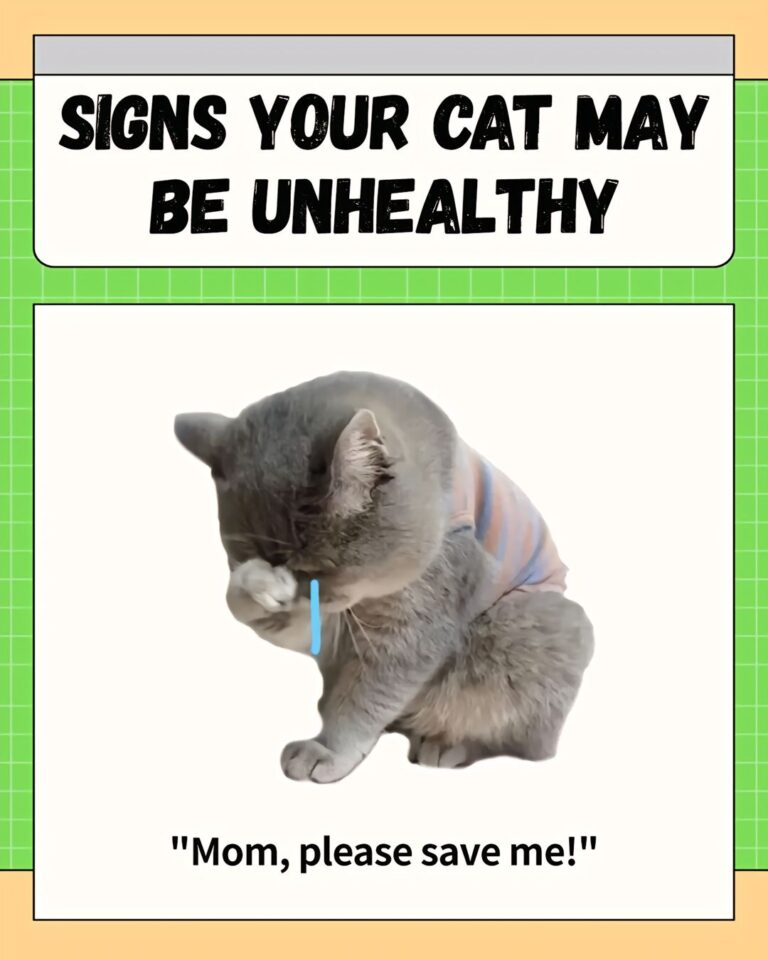
6 Alarming Signs Your Cat May Be Unhealthy: What Every Cat Owner Should Know
As a cat owner, it’s easy to get caught up in the joys of having a playful, affectionate companion. But just like us, cats can fall ill, and they often don’t show it right away. While cats are great at hiding discomfort, there are key signs that can reveal when they may be struggling with their health. Identifying these symptoms early can make all the difference in getting your feline friend the help they need before things get worse. Here are six signs to watch out for that may indicate your cat is unwell.
1. Frequent Scratching: More Than Just a Grooming Habit
We all know cats love to scratch—it’s in their nature to keep their claws sharp and mark their territory. But when scratching becomes excessive, it can be a sign that your cat is dealing with allergies, parasites, or skin infections. If you notice your cat scratching a specific area repeatedly or causing themselves harm, it’s important to investigate further.
Why it Happens: Excessive scratching can be a sign of fleas, mites, fungal infections, or even an allergic reaction to food, bedding, or cleaning products.
What to Do: If the scratching doesn’t stop or seems to be getting worse, consult your vet to rule out parasites, infections, or allergies. A trip to the vet may also help you get the right medication or treatment to relieve your cat’s discomfort.
2. Fever, Vomiting, Excessive Eye and Nasal Discharge: The Signs of Infection or Serious Illness
When your cat is running a fever, vomiting regularly, and has excessive eye and nasal discharge, this can indicate that they’re fighting off a respiratory infection or systemic illness. This combination of symptoms can be a serious warning that something is wrong and could indicate viral or bacterial infections, such as upper respiratory infections (URI), Feline Leukemia, or even FIP (Feline Infectious Peritonitis).
Why it Happens: These symptoms point to an underlying issue that could range from a simple cold to something more severe.
What to Do: Take your cat to the vet immediately if they exhibit these symptoms. A thorough check-up and lab tests may be needed to pinpoint the cause of the illness and start treatment.
3. Runny Nose and Sneezing: The Common Cold or More?
A runny nose and sneezing are common signs of a cold, but they can also be symptoms of allergies or even sinus infections. If your cat’s nasal discharge is clear, it could just be a mild cold. However, if it’s accompanied by other symptoms like fever, coughing, or decreased appetite, it may signal a more serious respiratory infection.
Why it Happens: Respiratory issues in cats can be caused by viruses like herpesvirus or bacteria, or they may be suffering from a sinus infection or environmental allergies.
What to Do: If the sneezing and runny nose persist, especially if accompanied by lethargy or loss of appetite, consult your vet for proper diagnosis and treatment.
4. Squatting Like a Hen: Signs of Pain or Digestive Problems
If your cat suddenly starts squatting low to the ground, almost like a hen, and this behavior is accompanied by poor appetite, lack of energy, or vomiting, it may indicate gastrointestinal issues, including constipation, diarrhea, or even intestinal blockages. This behavior may also point to pain caused by conditions like urinary tract infections (UTI) or kidney issues.
Why it Happens: The squatting motion can be a sign that your cat is trying to relieve themselves but is struggling due to discomfort in their digestive or urinary systems.
What to Do: If your cat starts squatting like this and doesn’t relieve themselves or seems to be in pain, it’s time to visit the vet. Intestinal blockages or urinary tract issues can be serious and may require immediate attention.
5. Vomiting and Diarrhea: A Double Trouble Warning
Occasional vomiting and diarrhea in cats are often linked to hairballs or a slight upset stomach. However, when these symptoms are frequent or severe, it could signal something more serious, such as gastrointestinal infections, parasites, or food intolerances. If your cat experiences diarrhea with blood, this is a sign that immediate attention is needed.
Why it Happens: Vomiting and diarrhea are often linked to infections, parasites, or ingesting something harmful. Food allergies or intolerances can also cause these symptoms.
What to Do: If your cat experiences frequent vomiting or diarrhea, especially with blood or a lack of appetite, see your vet as soon as possible. These could be signs of a serious issue that needs to be addressed quickly.
6. Kicking Ears: Discomfort and Irritation
If your cat is constantly kicking their ears, scratching at them, or shaking their head, it could be a sign that they’re suffering from an ear infection or ear mites. These conditions are often accompanied by discharge or bad smell from the ears, and your cat may become increasingly irritable due to the discomfort.
Why it Happens: Ear infections and mites cause irritation, leading your cat to scratch or shake their head in an attempt to relieve the discomfort. This is especially common in outdoor cats, but it can affect any cat.
What to Do: Inspect your cat’s ears for redness, discharge, or foul odor. If you notice any of these signs, it’s important to take them to the vet for treatment to clear up the infection or eliminate ear mites.
Why These Signs Matter
As cat owners, we want to do everything we can to keep our pets healthy and comfortable. Recognizing when something isn’t right is the first step toward getting them the care they need. Cats are experts at hiding their discomfort, so it’s important to watch for subtle signs of illness, especially if these behaviors persist for more than a few days.
By staying aware of these common health issues and seeking professional care early, you’ll help your cat get back to their playful, happy self in no time.
Don’t wait—share these signs with other cat parents! The earlier we detect potential health problems, the better we can ensure our cats live long, healthy lives by our side.






